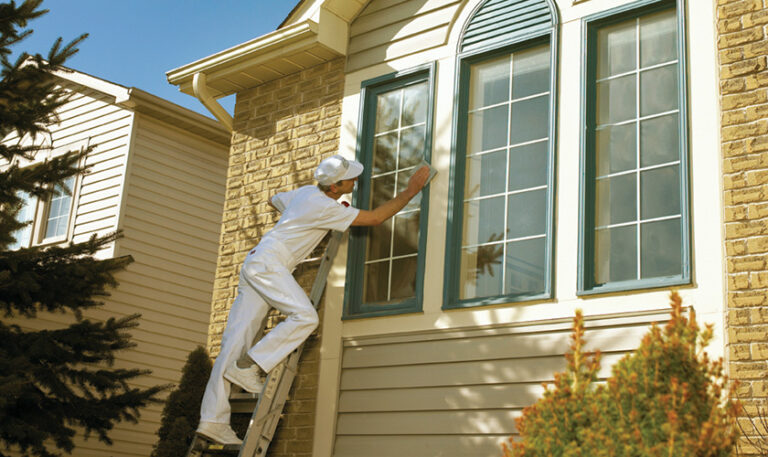Just as you’re admiring your home’s exterior, you notice the paint isn’t as vibrant as it once was. The question pops up – how often should you repaint your house exterior? It’s crucial to know, not just for looks but also for your home’s upkeep.
Factors like paint quality, climate, and your home’s location and siding material can influence that timeline. Intriguingly, it isn’t as straightforward as you might think. Let’s explore this further, shall we?
Key Takeaways
- The frequency of exterior house painting depends on the siding material, with varying ranges from 3 to 20 years.
- Signs your house exterior needs fresh paint include cracking, peeling, bubbling, fading color, and damage from elements.
- Factors like paint quality, location, climate, and weather impact the lifespan of the exterior paint.
Delayed repainting can lead to structural damage and decreased curb appeal, so regular inspections and maintenance are crucial.

Recognizing Signs of Wear
To keep your home in top shape, it’s crucial to recognize the signs of wear and tear such as cracking, peeling, and bubbling paint, or fading color due to sun and weather damage. These signs indicate that your house needs a fresh coat of paint. It’s essential to not ignore these signs, as they can lead to further damage if left untreated.
Another sign to look out for is cracking caulk around your windows and doors. This can lead to moisture damage, which can compromise the structural integrity of your home. If you notice gaps or shrinkage in your siding, it might be due to dry rot, another sign that your home needs a new paint job.
Painting Frequency per Siding Material
Depending on the material of your home’s siding, the frequency at which you’ll need to repaint can vary significantly. Wide-ranging materials exist, each with its own unique characteristics that dictate the longevity of your paint job.
Let’s get into the specifics:
- Wood siding – If your home has wood siding, you should anticipate painting every 3-7 years, or staining approximately every 4 years.
- Aluminum siding – Aluminum siding will require a fresh coat of paint approximately every 5 years.
- Stucco – Most stucco homes will need to be repainted every 5-6 years.
- Brick – If your home is primarily brick, you’ll only need to repaint every 15-20 years.
These guidelines are just that – guidelines. Keep in mind that the actual frequency can be influenced by several factors. Ultimately, the best way to maintain your home’s exterior is to regularly inspect the paint and act immediately when signs of wear and tear become apparent.
Influences on Paint Lifespan
While your home’s siding material plays a significant role in determining how often you need to repaint, it’s not the only factor to consider. The quality of the paint you use significantly influences its lifespan. High-quality paints typically last longer, resisting weathering and fading better than their cheaper counterparts.
Your location also plays a part in how long your paint lasts. Homes in coastal areas, for example, may require more frequent painting due to the corrosive effects of salt air. Similarly, if you live in an area with harsh winters or intense sun exposure, your exterior paint may deteriorate more quickly.
Climate, too, impacts the lifespan of your exterior paint. Wet, humid conditions can cause paint to peel and crack, while dry climates can cause it to fade and chalk.
Lastly, consider weather conditions. If your home is frequently exposed to severe weather like heavy rain, strong wind, or hail, you might find yourself repainting more often.
Prepping for a New Paint Job
Before you dive into a new painting project, it’s essential to properly prepare your home’s exterior to ensure a durable and appealing result. Good preparation can make the difference between a paint job that lasts for years, and one that starts to chip and peel within months.
- Cleaning: Start by thoroughly cleaning your house exterior. Use a power washer or a soft brush and soapy water to remove dirt, dust, cobwebs, and any mildew or mold. A clean surface provides the best base for new paint.
- Repair: Look for damaged or rotted sections of siding or trim. You’ll need to repair or replace these areas before you start painting.
- Sanding and Scraping: After your house is clean and repaired, sand and scrape any areas where the old paint is peeling or blistering. This ensures a smooth surface for the new paint to adhere to.
- Priming: Apply a high-quality primer to any bare wood or metal. This helps the paint adhere better and gives a more even finish.
Dealing With Sun Damage and Bubbling
Sun damage and bubbling are common issues you’ll encounter with your home’s exterior paint, and understanding how to deal with them can extend the life of your paint job. Sun damage often manifests as uneven fading, especially on parts of your home exposed to direct sunlight. You’ll notice certain areas looking bleached or lighter than others.
To manage this, you can opt for paint with UV protection, which can slow down the fading process. It’s also beneficial to use a high-quality primer before painting, as it provides an extra layer of protection against the sun.
On the other hand, bubbling happens when paint loses its adhesion and lifts from the underlying surface, creating a bubble-like appearance. This is often a result of painting on a hot surface or in direct sunlight, as the paint dries too quickly and traps in moisture.
To resolve bubbling, you’ll need to scrape off the bubbled paint, sand the area smooth, and then repaint. It’s crucial to paint during cooler temperatures and avoid direct sunlight to prevent recurring issues. With these strategies in mind, you’ll be well-equipped to extend the life of your paint job.
Addressing Cracks and Peeling Paint
Just as sun damage and bubbling can impact your home’s exterior, cracks and peeling paint are common problems you’ll need to tackle to maintain your home’s curb appeal. Cracks and peeling paint not only ruin your home’s aesthetic but also expose the underlying structure to damaging elements.
Here’s a four-step guide to help you address these issues:
- Identify the Problem Areas: Look for cracking or peeling paint on your home’s exterior. Pay close attention to areas that are exposed to harsh weather conditions or strong sunlight.
- Prep the Surface: Once you’ve identified the problem areas, it’s time to prep. Remove the peeling paint and sand the surface until it’s smooth.
- Fix the Cracks: Use a filling compound to fill in any cracks. Make sure the compound is compatible with your exterior surface.
- Apply Primer and Paint: Once the filler is dry, apply a coat of primer. After the primer is dry, paint over the area.
Tips to Extend Time Between Repaints
To keep your house looking fresh for longer, there are several steps you can take to extend the time between repaints.
Firstly, conduct regular inspections of your home’s exterior. Look out for signs of wear and tear like peeling, bubbling, and cracks. Don’t ignore these early signs of damage. By addressing them promptly, you can prevent bigger problems and extend the lifespan of your paint job.
Secondly, choose high-quality paint. It may cost more upfront, but it’s more durable and less likely to fade, peel, or crack. This means you won’t have to repaint as often.
Next, consider the impact of your local climate. If you live in a harsh environment, it’s worth investing in paint that’s formulated to resist weather-related damage.
Conclusion
So, there’s no one-size-fits-all answer to how often you should repaint your house exterior. It depends on your home’s siding material, the climate, and the quality of your last paint job.
Keep an eye out for signs of wear like sun damage, bubbling, or peeling paint. With proper prep work and maintenance, you can extend the life of your paint job.
Remember, your home’s exterior is its first defense against the elements – keep it in top shape!
Most Recent Blogs
Explore By Category
